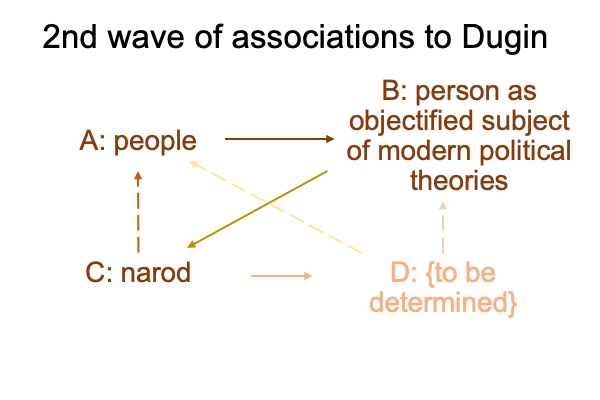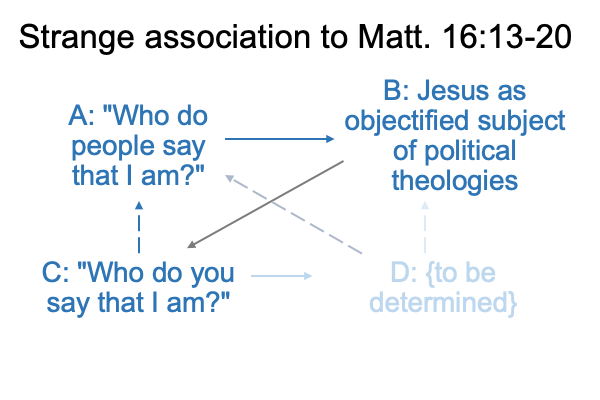0010 The previous discussion yields the following Greimas square.

0011 A is the subject of Dugin’s populism, the people.
B contains objectifications of the subject, according to modern political theories. These theories claim to be rooted in science. Yes, trust the science, even as each theory goes on to first order the people, then destroy the people on the altar of its own construction. Isn’t that what science does? It discovers the order of nature, a facet of God’s creation, then ambitious technologists use that discovery in order to create a weapon?
The pattern is ancient. But, premodern theories are not based on modern science. They are based on idolatries.
0012 This permits me to introduce a tangent not in Millerman’s text.
To me, the following strange association from the gospel of Matthew 16:13-20 mirrors Dugin’s approach, as rendered above.

0013 Here, the people (A) are those capable of ideating who Jesus is.
In Dugin’s approach, the people (A) are those capable of theorizing who they are. To me, this theorization requires speech-alone talk.
Speech-alone talk?
Consider Razie Mah’s short e-work, The First Singularity and Its Fairy Tale Trace, or the lengthy (and much more dramatic) An Archaeology of the Fall, available at smashwords and other e-work venues. Speech-alone talk defines our current Lebenswelt.
0014 Returning to the strange association, I ask, “How does B contrast with A?”
Here, B is how the people, who have no idea of what is really going on, regard Jesus in terms of contemporary political theologies. Who formulates these theories? Well, the Sadducees and Pharisees are self-anointed experts and they intend to remain that way. Indeed, they remain so until the second temple, and later, most everything else, is destroyed by the Romans, who are sorely pissed off by the rebelliousness of the province.
In Dugin’s approach, the people, who may or may not have any idea of what is really going on, embrace one or other political theory. These political theories exclude one another in the same way that sociology excludes biology and biology excludes chemistry and chemistry excludes physics. Even though the noumenon of the narod remains the same, the phenomena observed and measured by each political theory differs according to the way that the subject is objectified by each political discipline. Liberalism observes and models the individual. Communism observes and models the class. Fascism observes and models the state and race. Race is a special application of the state. “Race” is state imposition of the condition of “free” or “slave” on the basis of established criteria. How special is that?
0015 What about C in the strange association?
C contradicts B and complements A.
0016 Obviously, Jesus as an objectified subject of political theologies (B) is not who he is (A). Admission of that realitydefines (C).
So, Jesus asks a second question, where “you” (C) complements “people” (A), because “you” encompasses those living with Jesus. Indeed, it encompasses the Church as the Bride of Christ, the helper to the New Adam.
Also, the second question asks “you”, the disciples, to put the answer into spoken words.
0017 In Dugin’s approach, the narod is not the people as constituted in response to political theory, but the people as constituted by lived experience. The narod is personal. The narod is like a bride to her groom. Marriage is more than what spoken words can describe. The groom belongs to his bride.
0018 The narod (C) is the subject of the fourth political theory.
The narod cannot be understood by political science. Yet, political sciences have had their day. The people need a new political not-science. The people need a fourth political theory that is theoretical in the same way that the hermeneutical interpretation of the gospel according to to Matthew 16:13-20 is theoretical.
To this end, Dugin turns to the philosophy of Martin Heidegger.
